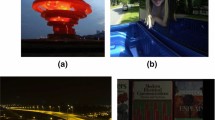Abstract
Images captured in low illumination conditions usually suffer from a poor visibility which has an important affect on the performance of computer vision systems. Thereby low illumination image enhancement is critical for image-related applications. In this paper, we proposed a photographic negative imaging inspired method for enhancing the images taken under low illumination environments. It consists of three basic components. First, the input night-time image is reversed to obtain its corresponding negative image (which is comparable with the latent image of a photographic film). Second, a rectification on the negative image is performed (Which is comparable with the chemical development in the process of film processing) by using an image dehazing method. This operation is inspired by the observation that the negative image looks like a hazed image and thereby it can be enhanced using a dehazing method. Third, the rectified negative image is reversed to obtain the final enhanced image (Which is comparable with the operation of fixing in the later stage of film processing.). Experiments over a large quantity of low contrast night-time images show that the proposed method is effective for enhancing low illumination images. Compared with six state-of-the-art image enhancement methods, the proposed method is superior to them in both enhancing image quality and decreasing time cost.














Similar content being viewed by others
References
Chang J, Bai J (2015) An image enhancement algorithm based on Gaussian weighted bilateral filtering and retinex theory. In Proceedings of the 8th International Congress on Image and Signal Processing, IEEE, pp 257–262
Elad M (2005) Retinex by two bilateral filters. In Scale Space and PDE Methods in Computer Vision (pp. 217–229). Springer Berlin Heidelberg
He K, Sun J, Tang X (2011) Single image haze removal using Dark Channel prior. IEEE Trans Pattern Anal Mach Intell 33(12):2341–2353
He K, Sun J, Tang X (2013) Guided Image Filtering. IEEE Trans Pattern Anal Mach Intell 35(6):1397–1409
Hogervorst MA, Toet A (2010) Fast natural color mapping for night-time imagery. Information Fusion 11(2):69–77
Huang SC, Yeh CH (2013) Image contrast enhancement for preserving mean brightness without losing image features. Eng Appl Artif Intell 26(s 5–6):1487–1492
Jang IS, Park KH, Ha YH (2009) Color correction by estimation of dominant chromaticity in multi-scaled retinex. J Imaging Sci Technol 53(5):501–512
Jang IS, Lee TH, Ha HG, Ha YH (2010) Adaptive color enhancement based on multi-scaled Retinex using local contrast of the input image. Optomechatronic Technologies (ISOT), 2010 International Symposium on (pp.1–6). IEEE
Jang CY, Hyun J, Cho S, Kim HS, Kim YH (2012) Adaptive selection of weights in multi-scale retinex using illumination and object edges. In Proceedings of the International Conference on Image Processing, Computer Vision, and Pattern Recognition (IPCV) (p. 1). The Steering Committee of The World Congress in Computer Science, Computer Engineering and Applied Computing (WorldComp)
Jang CY, Lim JH, Kim YH (2012) A fast multi-scale retinex algorithm using dominant ssr in weights selection. ISOCC 37–40. doi:10.1109/ISOCC.2012.6406919
Jobson DJ (1997) A multiscale retinex for bridging the gap between color images and human observation of scenes. IEEE Trans Image Process 6
Jobson DJ, Rahman Z, Woodell GA (1997) Properties and performance of a center/surround retinex. IEEE Trans Image Process 6(3):451–462
Kuang H, Chen L, Gu F, Chen J (2016) Combining region of interest extraction and image enhancement for night-time vehicle detection. Intelligent Systems IEEE:1–1
Land EH (1986a) Recent advances in retinex theory. Vis Res 26(1):7–21
Land EH (1986b) An alternative technique for the computation of the designator in the retinex theory of color vision. Proc Natl Acad Sci 83(10):3078–3080
Lin SCF, Wong CY, Rahman MA, Jiang G, Liu S, Kwok N et al (2015) Image enhancement using the averaging histogram equalization (avheq) approach for contrast improvement and brightness preservation. Comput Electr Eng 46:356–370
Qian X, Wang Y, Wang B (2012) Fast color contrast enhancement method for color night vision. Infrared Phys Technol 55(1):122–129
Rahman ZU, Jobson DJ, Woodell GA (2011) Investigating the relationship between image enhancement and image compression in the context of the multi-scale retinex. J Vis Commun Image Represent 22(3):237–250
Robinson PE, Lau WJ (2012) Adaptive multi-scale retinex algorithm for contrast enhancement of real world scenes
Tarel JP, Hautiere N (2009) Fast visibility restoration from a single color or gray level image, in Proc. IEEE Int. Conf. Computer Vision (ICCV), Kyoto, 29 September–2 October 2009, pp. 2201–2208
Tsagaris V, Anastassopoulos V (2005) Fusion of visible and infrared imagery for night color vision. Displays 26(4–5):191–196
Wang W, Li B, Zheng J, Xian S (2008) A fast multi-scale retinex algorithm for color image enhancement. International Conference on Wavelet Analysis and Pattern Recognition 1:80–85
Xiao J, Song SP, Ding LJ (2008) Research on the fast algorithm of spatial homomorphic filtering. Journal of Image & Graphics 13(12):2302–2306
Xu Q, Jiang H, Scopigno R, Sbert M (2014) A novel approach for enhancing very dark image sequences. Signal Process 103(10):309–330
Yin S, Cao L, Ling Y, Jin G (2010) One color contrast enhanced infrared and visible image fusion method. Infrared Phys Technol 53(2):146–150
Zhao H, Xiao C, Zhao H (2015) Chapter 16: night color image enhancement via statistical law and retinex. Emerging Trends in Image Processing Computer Vision & Pattern Recognition:249–261
Zhou Z, Sang N, Hu X (2014) Global brightness and local contrast adaptive enhancement for low illumination color image. Optik - International Journal for Light and Electron Optics 125(6):1795–1799
Acknowledgements
This work was supported in part by a grant from the National Natural Science Foundation of China (No. 61202198, No.61401355, No. 41601353), a grant from the China Scholarship Council (No.201608610048), the Key Laboratory Foundation of Shaanxi Education Department (No.14JS072) and the Nature Science Foundation of Science Department of PeiLin count at Xi’an(GX1619). The authors gratefully acknowledge the helpful comments and suggestions of the reviewers.
Author information
Authors and Affiliations
Corresponding author
Rights and permissions
About this article
Cite this article
Shi, Z., Zhu, M., Guo, B. et al. A photographic negative imaging inspired method for low illumination night-time image enhancement. Multimed Tools Appl 76, 15027–15048 (2017). https://doi.org/10.1007/s11042-017-4453-z
Received:
Revised:
Accepted:
Published:
Issue Date:
DOI: https://doi.org/10.1007/s11042-017-4453-z




